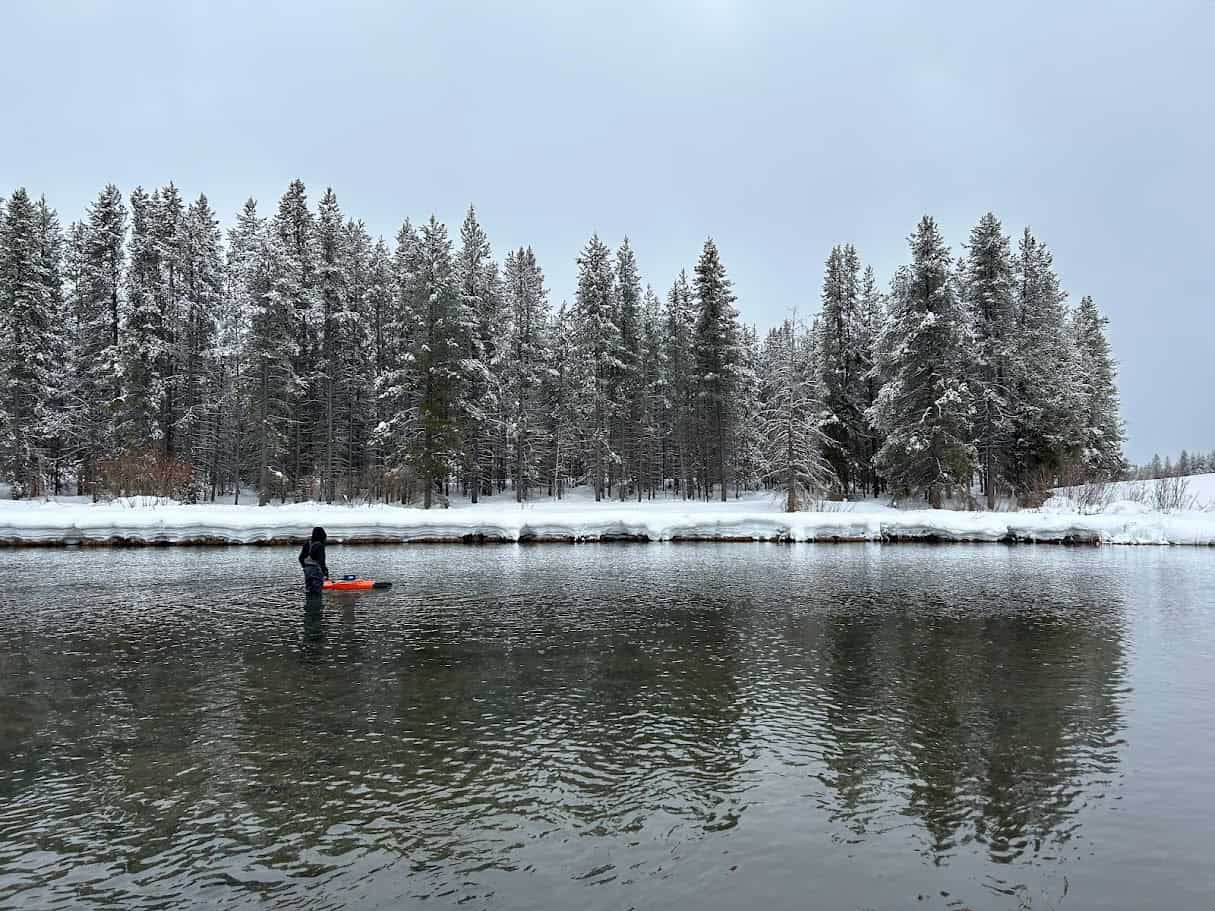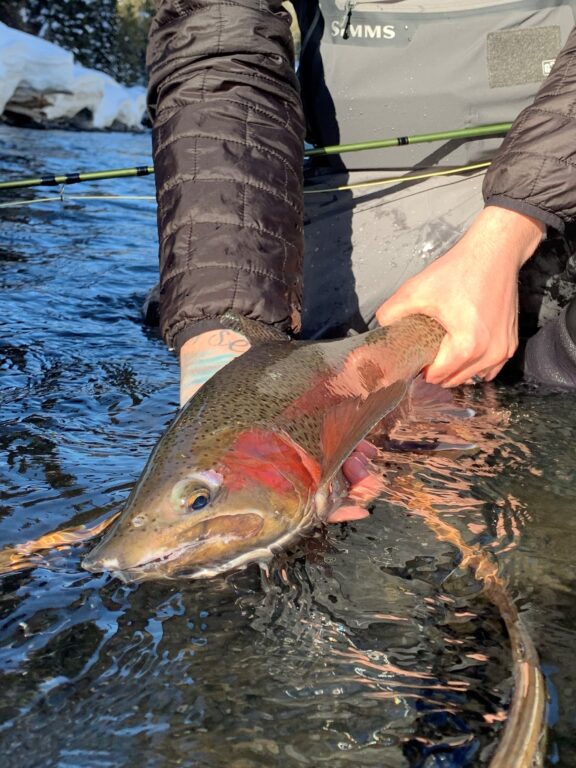This is the fifth and final installment of a five-part series investigating the various effects of receiving more precipitation as rain versus snow in the Henry’s Fork watershed. This installment was originally included in a daily water report sent March 8, 2024.
The big takeaway:
Increasing spring and summer air temperatures have a doubly negative affect on water quality, directly via water temperatures and indirectly via lower water supply.
The details:
Today’s topic brings us back to the fundamental driver of why we are seeing trends toward lower snow fractions, lower runoff efficiency (streamflow yield per unit of precipitation), and lower water supply, despite no trend whatsoever in total precipitation. The primary driver is temperature, along with secondary but related effects from increased evapotranspiration in upland areas.
We saw yesterday that maximum summer water temperature was the single most important driver of aquatic insect communities. The effect of air temperature on water temperature is obvious, and we have verified this statistically. In some river reaches, lower streamflow can lead to warmer water temperatures, but that effect is not universal, and in some locations the opposite can be true. In river reaches such as Osborne Bridge to Pinehaven, groundwater inputs from springs cool the river during the middle of the summer, and the cooling effect of those groundwater inputs is greater when streamflow is lower. This can also happen locally on the river downstream of St. Anthony. And, we have also shown that higher summertime outflow from Island Park Dam results in more rapid reservoir draft and warmer water temperatures in the reservoir. Because Island Park Reservoir is shallow and cannot support a large cold-water pool at the bottom as it is drafted, higher summertime outflow results in warmer temperatures in the river downstream, the opposite of what is observed downstream of large, deep reservoirs that retain large cold-water pools at the bottom of the reservoir all summer.
The rest of this discussion is focused on Island Park Reservoir, where the greatest water-quality issues in the watershed originate. Increased water temperatures and increased sediment export from the reservoir are the two issues we hear about most often from anglers. The invertebrate data I summarized yesterday corroborate the concerns of those anglers—yes, it’s true that the insects desired by anglers are less abundant when temperatures are warm and suspended sediment concentrations are high. This is true watershed-wide, but it is most obvious in the Harriman reach, where water quality is most strongly affected by Island Park Reservoir.
The four-panel graphic today shows the best single-predictor models of four measures of water quality downstream of and in Island Park Reservoir. Not surprisingly, temperature and streamflow are the most important predictors. Summer-time turbidity (a measured surrogate for suspended sediment concentration) is most strongly predicted by outflow, which is regulated and dependent on watershed-wide irrigation demand and water supply, not by conditions occurring strictly in the reservoir and its watershed. Similarly, summer-time suspended sediment load (the total mass of sediment exported out of the reservoir) is also most strongly predicted by reservoir outflow. Water temperature, on the other hand, is more strongly predicted by reservoir inflow, which is largely the river’s natural flow from Big Springs and other headwater sources. When this is higher, more cool water comes into the reservoir, keeping it cooler. Over a longer period of record, Jack McLaren found that reservoir draft (outflow minus inflow) is actually a stronger predictor, but over the 10-year period of record since we first installed our water-quality sondes, inflow itself is the strongest single predictor.

The lower right panel is a little different and more complex. The response variable is the probability that the reservoir is eutrophic, a state of having so much productivity that dissolved oxygen concentrations decline, potentially leading to harmful algal blooms and other negative consequences. Eutrophy is caused by a combination of high nutrient levels (usually phosphorus), warm temperatures, and abundant sunlight. In Island Park, eutrophic conditions can also contribute to increased turbidity and so generally reflect all of the negative aspects of water quality: high temperatures, low dissolved oxygen, high nutrient loads, increased turbidity, and increased probability of harmful algal blooms. Some of these processes create their own feedback loops so that once the reservoir becomes eutrophic, it tends to stay that way. In 2016, for example, a harmful algal bloom first occurred very early in the summer—around July 4—and reservoir water quality stayed very poor from then until it froze in November. This particular data set came from Dr. Tyler King at the U.S. Geological Survey in Boise and is based on remote imagery.
The lower right of the four panels shows that the primary predictor of eutrophy is air temperature. Interestingly, we found that the strongest temperature driver was temperature in the late winter and very early spring. We are still investigating the mechanism but are fairly certain that warm temperatures at this time of year result in early ice-off, which sets off the growing season and feedback loops very early in the year, as happened in 2015 and 2016, when ice melted in mid-April. By contrast, last year was very cool in the late winter and early spring, and ice didn’t melt until May 11. When combined with good stream inflow and relatively little reservoir draft, the result was very good water quality all the way around last year.
Note that the R² values for these largely physical relationships are much higher than those for the biological relationships described yesterday. The temperature-eutrophy R² value of 0.47 is the lowest of these, but it turns out that in a two-variable model that also includes natural inflow to the reservoir, the R² value increases to 0.52. Thus, these direct flow- and temperature-dependent relationships are strong.
The second graphic shows the temporal trend in eutrophy since 1989, and it is upward and statistically significant, reflecting in part the upward trend in temperature and downward trend in water supply we are also observing. Given the sensitivity of aquatic insects to water temperature and sediment, this trend toward overall lower water quality likely means downward trends in particular aquatic insects and community metrics. We are still calculating potential trends in the latter based on trends in the former. Regardless, the effect of warming temperatures is compounding: it directly results in lower water quality in the reservoir and the river, and it contributes to lower overall water supply. That, in turn, results in less natural inflow to Island Park Reservoir and higher summertime outflow, both of which pile on to the direct temperature effect to decrease water quality in the reservoir and river downstream.

Although this is not a positive message for those who highly value the unique hatches and dry-fly fishing experience of the Henry’s Fork downstream of Island Park Dam, the fact that we can now definitively quantify and define the trends and physical drivers of water quantity, water quality, and their combined effect on aquatic insects is actually good news because it will lead to solutions that will actually work to improve streamflow and water quality. These data formed the basis of a $1.7 million grant application to U.S. Bureau of Reclamation that we submitted in late January, entitled DIRTT: “Developing Infrastructure to Reduce Temperature and Turbidity.” Although we will not know if we will receive the grant for another few months, we will pursue some of the proposed infrastructure improvements and restoration actions over the next year regardless. If you would like a 2-page summary of the DIRTT plan to see what we have in mind, send me an email and I’ll send it to you.








